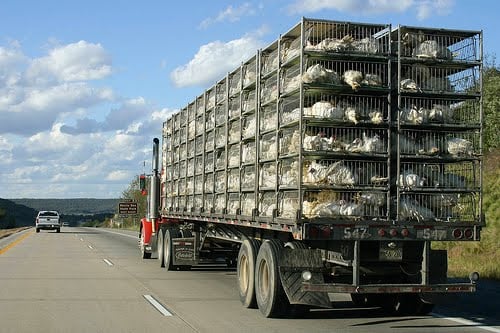One of the major causes of stress in poultry is transportation. Poultry stress generally has adverse impact on the health and the productivity of the chicken and will in many cases lower the immunity of the chicken, cause health complications, lower the production levels of the poultry and increase the cost of production.

The main physiological symptoms of poultry stress include the following:-
- Immune suppression
- Weight loss
- Increased susceptibility to poultry diseases
Moving your chickens from one location to another is generally a necessity in a poultry farming operation. You may need to move newly hatched chicks to a brooder in another farm or pullets from one farm to another. However, the transportation of poultry is more like going to cause serious stress or even deaths if not carried out well. In many extreme cases, chickens will die of stress.
There are various key factors that you need to figure out when transporting your chickens so as to minimize the stress and production losses.
Poultry Stress and the Best Way to Transport Your Chickens
Chickens, by nature, are highly sensitive. They are very nervous livestock which makes their relocation a nightmare. Any turbulence, loud noises, disruptions in their usual environment, bright lights or even open spaces can easily lead to poultry stress when they are being transported from one location to another.
But there are various proven techniques that can be used to reduce the risk of stress in poultry. Each of these techniques will require careful control and application so that the transportation environment will result in very minimal disruptions.
Creating a Healthy Environment for Transportation
The first step is to create a very healthy environment and you can do this by providing fresh air and water. Chickens don’t have sweat glands so they can easily overheat when placed in a poorly ventilated area during warm weather. Choose a vehicle with good ventilation that will allow free airflow during transportation. Each of the travel crates used in transporting the poultry should also have breathing slots.
Chickens are generally calmer and more comfortable when they can feel free flowing air. You can equate this to the feeling you get when you are enjoying a cool summer breezes by the sea. As much as you would wish to ensure that the chickens are properly ventilated during the transportation, you should take care not to use a transport vehicle that is completely open to the elements. An open air vehicle is not going to protect the chickens from the dust, rainfall, debris from the road or even strong gusts of wind.
The chickens will also need to access fresh water every few hours during transportation otherwise they are going to suffer more dehydration and stress. If you are taking very long trips, you will also need to feed the chickens every four hours.
The bottom line: When transporting your chickens, make sure that they are always well supplied with fresh water, food and have good airflow. The transportation should be done with the least disturbance possible.
Use Small and Dark Boxes
For the chickens to feel the light breeze or airflow during transportation, it is imperative that you limit their access to light. The use of small and dark crates will help reduce the poultry stress levels. Inspect the air holes in the crates to ensure that they will not let in too much light. When in the dark, the chickens will go through a sleep-like phase that helps keep them calm and relaxed. Try as much as possible to make your transportation crates darker while still allowing a lot of fresh airflow at the same time.
You should also avoid overcrowding. Use smaller crates that can hold two or three chickens. Snug quarters in the transportation crates will also prevent the movement of the chickens during transportation. The company of the other chickens in the crates will also help keep the chickens calm.
Have a Smooth and Quiet Trip
When transporting your poultry over longer distances, avoid bumpy routes such as those with lots of traffic, loud noises, lots of construction work as well as rough and bumpy roads. A smooth and quit drive generally reduces the chance of the poultry undergoing stress.
Before you embark on a journey transporting the chickens to their destination, you can minimize the amount of stress that the chickens are likely to experience by putting the crates containing the chickens on a sound-absorbent surface. Use blankets or rubber mats, for example. If possible, use an insulated vehicle.
Prepare the Poultry Housing
Before you move the chicken to their destination, make sure that you have prepared the poultry housing in advance so as to minimize the stress on the chickens. Some of the essentials that you should include in the new poultry housing include the following:-
- Fresh water and feeds
- Clean bedding: this can include either straw or shavings
- The shelter should be in an enclosure that will also protect the chickens from predators
When transporting your chickens to their new destination, you want their new environment to be as normal and comfortable as possible when the chickens arrive. To achieve the best result and minimize the stress as much as possible, you need to ensure that everything is in order before you begin the transportation.
These simple steps will go a long way in minimizing the stress that your poultry are likely to experience during transport. Additionally, you can also take precautionary measures and institute a stress management program for your chickens. A stress management program for your poultry will help in preventing the early onset of stress and thus allow your chickens to have optimal health even in their new environment.

